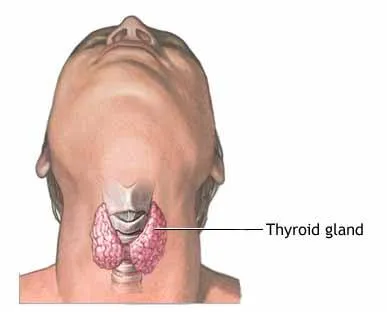Functions of Thyroid Gland and it's Hormones, Thyroid Location
Thyroid gland is the largest endocrine gland in adult human. Endocrine glands are those that secrete their products directly into the bloodstream. In contrast, most exocrine glands release their secretions through a duct onto an epithelial surface such as skin or mucosa. Thyroid gland is made up of two lateral lobes joined together across midline by a narrow bridge of tissue called isthmus. It is relatively larger in women and children than in men.

Location of thyroid gland
Thyroid gland lies in the anterior part of our neck, immediately below the larynx and overlying the trachea (windpipe). A normal thyroid gland weighs between 25 and 40 gm. This butterfly shaped gland is highly vascular so it receives one of the highest rates of blood flow per gram of tissue. Thyroid gland moves with the larynx in swallowing and speaking - this feature helps a healthcare professional to differentiate swellings in the glands from those in the adjacent structures.

Control of thyroid hormone secretions
Iodine is essential for thyroid hormone synthesis. Dietary intake of about 150 microgram per day mainly in the form of iodide is typical to maintain normal thyroid hormone secretion. In many countries common table salt is iodized to prevent iodine deficiency. Iodine deficiency is the most common cause of goiter which is considered as one of the thyroid diseases.
Thyroid hormones (TH) are secreted mainly in response to TSH (thyroid stimulating hormone) released from the pituitary gland. Pituitary which is also an endocrine gland located within our brain and attached to the lower surface of the hypothalamus. Secretion of TSH in turn is dependent on another hormone called TRH (thyrotropin releasing hormone) that is released from the hypothalamus.
Functions of thyroid hormones
- Thyroid gland functions include the secretion of two major hormones T3 (also called Triiodothyronine) and T4 (also known as Thyroxine or Tetraiodothyronine). T3 is physiologically more active and more potent than T4. T3 and T4 are collectively called thyroid hormones (TH). Both are iodine containing amino acids. Thyroid hormones are anabolic in nature; anabolism pertains to the constructive phase of metabolism and is the opposite of catabolism, the destructive process of metabolism.
- Thyroid hormones cause increased heart rate, cardiac output and ventilation rate.
- T3 and T4 act on various target cells to increase oxygen consumption and the basal metabolic rate (BMR). BMR is the rate of energy expenditure in the body under basal conditions. Increased oxygen consumption and increased BMR lead to increased heat production in the body that in turn helps to compensate for increased heat loss in cold weather. BMR is usually measured 12 hours after eating and after a restful sleep in a comfortable temperature with no exercise or activity before the test. BMR is increased in individuals with hyperthyroidism which is a thyroid gland dysfunction. In hyperthyroidism, patients experience tachycardia, nervousness, muscle wasting and excess heat.
- Thyroid hormones increase glucose absorption from the small intestine and hepatic glucose production; however, patients with normal insulin concentration do not experience elevated serum glucose level.
- Thyroid hormones are essential for normal growth and maturation. They play crucial role in the development of central nervous system (CNS). The most serious effect of thyroid hormone deficiency during childhood is permanent brain damage and dwarfism.
- Thyroid hormones accelerate cholesterol clearance from the plasma.
- Thyroid hormones are required for conversion of carotene to vitamin A; patients with hypothyroidism may suffer from night blindness.
- Thyroid gland also releases a minor hormone called calcitonin which is involved in calcium and phosphate metabolism. Calcitonin stimulates cartilage growth and causes increased deposition of calcium in the bones therefore promoting bone formation and reducing calcium concentration from the blood.


